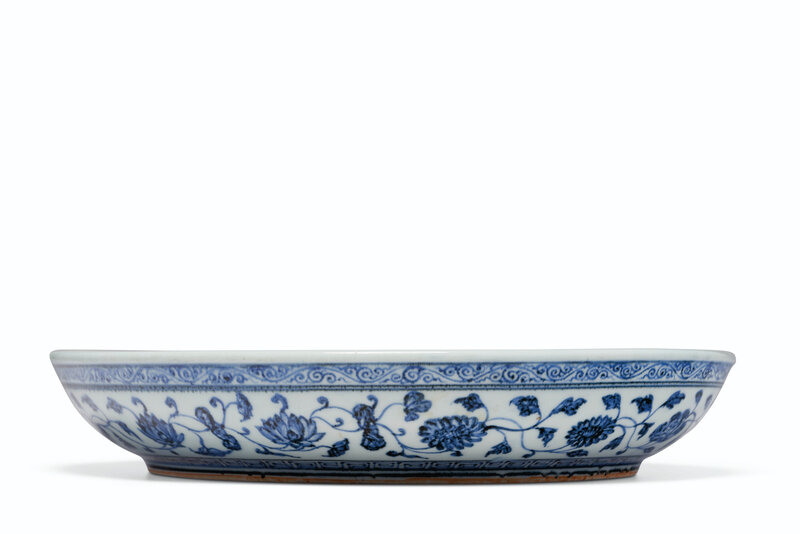The dish is finely decorated with a central ribbon-tied lotus plant incorporating sagittaria and millet encircled by composite floral scroll.
Provenance: W.D. Horne Collection.
Sotheby's London, 9 December 1975, lot 127.
Sotheby Parke Bernet Ltd., Hong Kong, 8 November 1982, lot 97.
The Lenora and Walter F. Brown Collection, San Antonio, Texas.
Note: The design on this dish is typically described as 'lotus bouquet,' as the majority of the flowers, pods and leaves belong to the auspicious lotus plant. However, the bouquet also includes additional auspicious plants, such as the arrow-shaped saggitaria sagittifolia, a symbol of both generosity and of food in a time of shortage, and a stalk of millet, symbolizing an abundance of grain. Dishes with this 'lotus bouquet' design belong to an important group of early Ming blue and white wares, together with 'grape' dishes, 'melon' dishes, and 'dragon' dishes. See J.A. Pope, Chinese Porcelains from the Ardebil Shrine, Washington, D.C., 1956, p. 92, where he discusses the thirty-four 'bouquet' dishes of varying size and with varying borders in the Ardebil Shrine Collection, showing the wide range of intensity of cobalt and the diversity of decoration. Some of these variations can be seen, ibid., on pls. 30 and 31.
These so-called 'lotus bouquet' dishes are characteristic of the finest blue and white wares of the Yongle reign. Some examples, like the present dish, have a classic scroll band around the inner rim, and some have a narrow wave band. A ‘lotus bouquet’ dish with scroll band was excavated from the Yongle stratum of the site of the imperial kiln at Jingdezhen in 1994, and is illustrated in Imperial Hongwu and Yongle Porcelain Excavated at Jingdezhen, Chang Foundation, Taipei, 1996, no. 40. Compare, also, two other dishes of this pattern, but of slightly larger size: one in the National Palace Museum, Taipei, (34.2 cm. diam.), illustrated in Porcelain of the National Palace Museum: Blue-and-White ware of the Ming Dynasty, Book II, Part 2, Hong Kong, 1963, pp. 146-7, pl. 59; and one in The Tianminlou Foundation, (34.7 cm. diam.), illustrated in the catalogue of the Min Chiu Society exhibition, Joined Colors, Sackler Gallery, Washington, DC, 1993, p. 78, no. 7. A similar dish of slightly larger size (41 cm. diam.) is in the Topkapi Saray, Istanbul, and is illustrated in J. Ayers and R. Krahl, Chinese Ceramics in the Topkapi Saray Museum, Istanbul, vol. II, Yuan and Ming Dynasty Porcelain, London, 1986, p. 514, no. 604 (where another one of slightly smaller size (31 cm. diam.) is noted). One with the collector’s mark of Shah Abbas, 33.8 cm. diam., is illustrated by T. Misugi in Chinese Porcelain Collections in the Near East: Topkapi and Ardebil, Hong Kong, 1981, p. 115, no. A.30, along with two examples decorated with a wave border, p. 114, nos. A.28 and A.29.
Christie's. Important Chinese Ceramics and Works of Art, New York, 25 September 2020

/https%3A%2F%2Fprofilepics.canalblog.com%2Fprofilepics%2F1%2F0%2F100183.jpg)
/https%3A%2F%2Fstorage.canalblog.com%2F03%2F02%2F119589%2F96711876_o.jpg)
/https%3A%2F%2Fstorage.canalblog.com%2F11%2F31%2F119589%2F94773502_o.jpg)
/https%3A%2F%2Fstorage.canalblog.com%2F20%2F83%2F119589%2F94772815_o.jpg)
/https%3A%2F%2Fstorage.canalblog.com%2F26%2F72%2F119589%2F75604929_o.jpg)
/https%3A%2F%2Fstorage.canalblog.com%2F59%2F60%2F119589%2F26458628_o.jpg)





/image%2F1371349%2F20240416%2Fob_2a8420_437713933-1652609748842371-16764302136.jpg)
/image%2F1371349%2F20240414%2Fob_83ee65_2024-nyr-22642-0954-000-a-blue-and-whi.jpg)
/image%2F1371349%2F20240414%2Fob_15808c_2024-nyr-22642-0953-000-a-blue-and-whi.jpg)
/image%2F1371349%2F20240414%2Fob_e54295_2024-nyr-22642-0952-000-a-rare-blue-an.jpg)